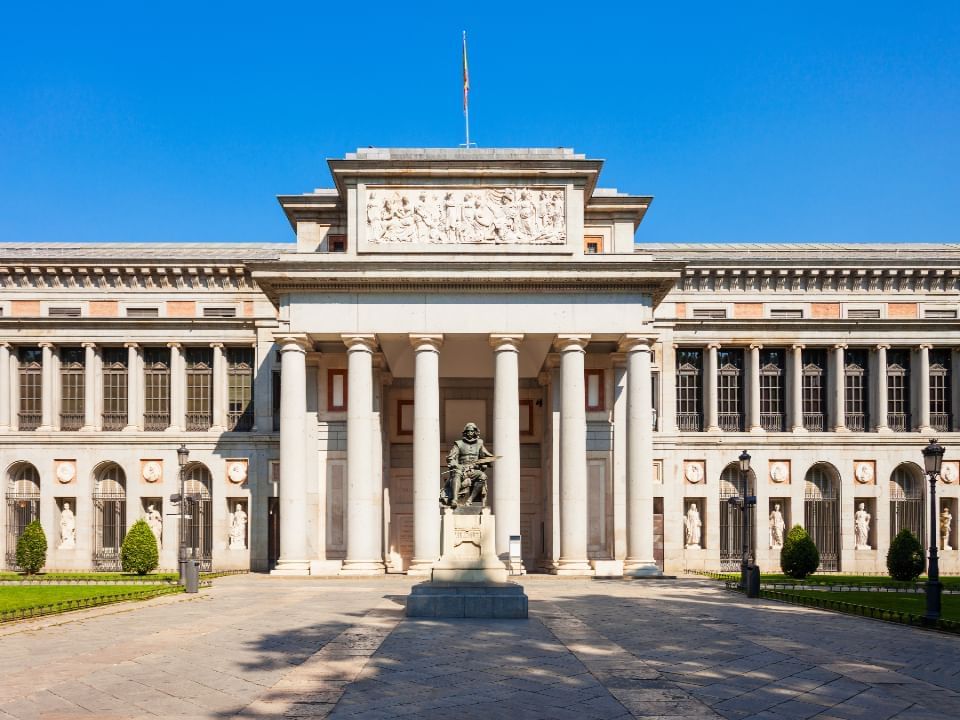The Prado Museum: A Jewel of Art in Madrid
The Museo Nacional del Prado is one of the Madrid's most emblematic museums and one of the major art galleries around the world. Its extraordinary collection of Spanish art makes it a pillar of the '.Madrid's art triangle', together with the National Museum Thyssen-Bornemisza and the Museo Nacional Centro de Arte Reina Sofía. Founded in 1819The Prado houses an impressive array of paintings, sculptures, prints and drawings from the 11th century to the modern era.

The Most Representative Collections
The Museo del Prado collection is primarily known for its large display of Spanish painting, but also stands out for its impressive selection of international artists. In terms of Spanish painting, the Prado is home to the works of the most celebrated masters in the history of Spanish art. From the Mozarabic murals in the church of San Baudelio in Berlanga to the works of renaissance and baroque painters such as El Greco, Velázquez and Goya. The museum offers an impressive variety of canvases that reflect the artistic evolution of Spain.
Velázquez one of the great geniuses of Western art, is represented in the museum with his famous work Las Meninas one of the most studied and admired paintings in the world. You can also admire other masterpieces by this painter such as Las Hilanderas. From Goya the museum houses a vast collection that includes the celebrated Black Paints and the striking images of the 3 May shootings. The museum also offers a rich collection of works by Sorolla, who is distinguished by his luminous landscapes and scenes from everyday life.
An essential visit to the Monastery
The El Escorial Monastery The dimensions are surprising: 207 metres long by 161 metres wide, with a 15 cloisters, 16 courtyards, more than 1,000 doors and more than 2,500 windows. Among its most notable spaces are:
- The Basilicawith a Greek cross plan and frescoes by Luca Giordano.
- The Royal Librarywhich houses thousands of manuscripts and ancient books, decorated with a vault painted by Pellegrino. Tibaldi.
- The PantheonsThe most important of these is that of the Kings, with marble and jasper that evoke the grandeur of the Habsburgs.
- The King's HouseThe austere and simple church, where Philip II spent his last days.
- The Battle Roomwith frescoes celebrating the military victories of the Spanish monarchy.
- The Palaces of the Habsburgs and the Bourbonswhere you can appreciate both the sobriety of the Habsburgs and the opulence of the Bourbons.
In addition, it is worth visiting the Museum of Painting the Museum of Architecture the Courtyard of the Kings and the Chapter Rooms.
Works by International Masters
The Prado Museum not only offers the best of Spanish art, but also houses an outstanding collection of international painting. Visitors can admire pieces by Italian and Flemish artists who profoundly influenced Spanish art. Among the most outstanding works are those by the great Italian masters such as Fra Angelico, Botticelli and Caravaggio who marked the transition between the Renaissance and the Baroque periods. In addition, the museum has an extensive collection of Flemish painting, including pieces by Van der Weyden and Boschamong others.
History and Foundation of the Museum
The history of the Prado Museum begins to late 18th century In 1819, King Charles III commissioned the construction of a building to house a Cabinet of Natural Sciences. However, it was his grandson, Ferdinand VII, who in 1819 allocated this space for the creation of the Royal Museum of Paintings and Sculptures, which marked the beginning of the Prado as a national museum. Over the centuries, the museum's collections have grown and evolved, enriched by the acquisitions of Spanish monarchs and various donations from collectors and artists.
Throughout its history, the museum has experienced crucial moments, such as the protection of its works during the Spanish Civil War, when they were kept on the ground floor of the museum under sandbags to prevent damage. In addition, some works were moved to Geneva during the Second World War for security reasons, but returned to Madrid after the end of the conflict.
Expansion and Modernisation of the Museum
In recent decades, the Prado Museum has undergone several extensions to accommodate the increase in visitors and the need for more space for its growing collections. The architect Rafael Moneo was commissioned to design the most recent extension, which connects the original building with the renovated Jerónimos cloister, creating a new entrance to the museum and enhancing the visitor experience. With this extension, the Prado now has new temporary exhibition rooms, an auditorium and more spaces dedicated to research and conservation.
The Prado Museum for Children
The Prado Museum is not only dedicated to art experts and collectors, but also strives to bring art to the youngest visitors. It offers special activities and workshops designed for children. This makes it an ideal place to enjoy art as a family. It is also advisable to book the activities in advance, as they are in great demand.
Gran Hotel Inglés: Your Perfect Base for Exploring the Prado
Located in the heart of Madrid, the Gran Hotel Inglés is an ideal choice for those wishing to discover the best of the city, including the Prado Museum.
Just a 10-minute walk from the museum, this 5-star Grand Luxury boutique hotel in the Barrio de las Letras offers a prime location for exploring the wonders of the Spanish capital. After a day spent enjoying the Prado's impressive works of art, you can relax in the hotel's elegant rooms, which combine classic luxury with modern comforts.
Book now and live the unique experience of staying at the Gran Hotel Inglés where comfort and history meet just a few steps away from one of the world's finest art collections!

